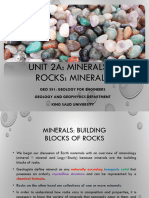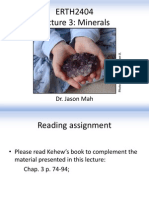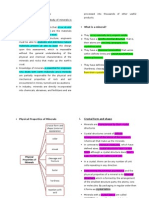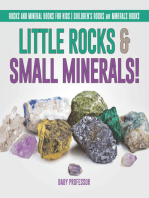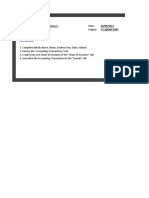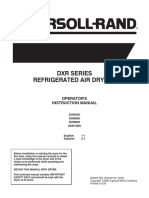Everyday Definition of Minerals
Everyday Definition of Minerals
Uploaded by
Vahlerii TesingCopyright:
Available Formats
Everyday Definition of Minerals
Everyday Definition of Minerals
Uploaded by
Vahlerii TesingOriginal Description:
Original Title
Copyright
Available Formats
Share this document
Did you find this document useful?
Is this content inappropriate?
Copyright:
Available Formats
Everyday Definition of Minerals
Everyday Definition of Minerals
Uploaded by
Vahlerii TesingCopyright:
Available Formats
6/28/2012
1
MINERALS
AND THE
MINERAL CYCLE
Everyday definition of Minerals
In everyday usage, the word mineral
can have several different meanings
Can mean something needed by our
body (vitamins and minerals)
Could be something a fertilizer
furnishes for a plant (nitrogen,
potassium, phosphorus)
Or could mean mineral
resources taken from the earth
for human use (i.e. sand, rock,
and coal)
Earth Science Definition
Naturally occurring, inorganic solid
element or compound with a
crystalline structure (can be
microscopic)
Cannot be synthetic, must not be
produced by a living organism, and
must have atoms arranged in a
regular, repeating pattern
So, are not only those exotic crystals
in museums or as valuable gems and
metals but any substance that meets
the above criteria
Crystal Structures of Minerals
Can be made up of atoms of one or
more kinds of elements
Examples:
Diamond with only carbon atoms in
a strong crystal structure
Quartz with atoms of silicon and
oxygen in a hexagonal prism crystal
structure
6/28/2012
2
Is coal a mineral?
Each mineral has its
own defined chemical
composition or range of
chemical compositions
Crystals classification
and identification
based on the symmetry
of their surfaces
Major systems in classifying
crystalline substances:
Isometric, hexagonal, tetragonal,
orthorhombic, monoclinic, triclinic
ISOMETRIC or CUBIC
All edges equal, all angles 90; Halite,
Fluorite, Pyrite, Galena, Garnet,
Magnetite, Gold, Copper, Diamond
HEXAGONAL
Angles of 60, 90, and 120; Ice
(snowflakes), Quartz, Beryl,
Corundum, Hematite, Calcite,
Dolomite
Isometric (cubic)
HALITE GALENA
GARNET FLOURITE
6/28/2012
3
Hexagonal
Snowflake
BERYL CORUNDUM
CALCITE
TETRAGONAL
Two edges equal, all angles 90;
square cross-section but different
third dimension; Zircon, Chalcopyrite
ORTHORHOMBIC
No edges equal, all angles 90; Like
the shape of a cereal carton; Olivine,
Andalusite, Sillimanite, some
Amphiboles and Pyroxenes, Topaz,
Sulfur
Tetragonal
ZIRCON
CHALCOPYRITE
RUTILE
Orthorhombic
OLIVINE
TOPAZ
SULFUR
MONOCLINIC
No edges equal, two angles 90;
shape obtained by knocking the ends
out of a carton and skewing it; some
Amphiboles and Pyroxenes, Micas,
Gypsum, Epidote; Sugar also belongs
to this crystal class
Monoclinic
GYPSUM
MICA
EPIDOTE DIOPSIDE
6/28/2012
4
TRICLINIC
No edges equal, no 90angles; most
Feldspars, Kyanite, Clay Minerals
KYANITE
ALBITE
(amazonite)
Physical Properties of Minerals
Cleavage, crystal form, hardness,
density, color, luster, streak
Cleavage tendency of a crystalline
substance to split or break along
smooth planes parallel to zones of
weak bonding in the crystal structure
Graphite structure
Diamond structure
Hardness a measure of a minerals
resistance to abrasion; a measure of
the strength of the atomic bonds in a
crystal
Density ratio of the weight of a
substance to its volume; depends on
how closely atoms are packed in the
crystal structure
6/28/2012
5
Mohs Hardness scale
Mineral
Assigned
Hardness
Test Used
Talc 1
Gyspsum 2
Calcite 3 Fingernail
Fluorite 4 Copper coin
Apatite 5 Copper coin
Orthoclase (K-feldspar) 6 Knife blade or glass plate
Quartz 7 Knife blade or glass plate
Topaz 8 Steel file
Corundum 9 Steel file
Diamond 10 Steel file
Color one of the most obvious
properties of a mineral, but not
diagnostic
Luster describes the appearance of
light reflected from a minerals
surface; 2 basic kinds: metallic and
non-metallic
Streak refers to the color or a
mineral in powder form and is usually
more diagnostic than the color of a
large specimen
Example: pyrite or fools gold vs. true
gold
How to streak
Rub mineral vigorously against the
surface of an unglazed white porcelain
Minerals softer than the porcelain leave
a streak, or line of fine powder
Minerals harder than the porcelain, a
fine powder can be made by crushing a
mineral fragment; the powder is then
examined against a white background
You might also like
- Job Safety Analysis For Highmast ErectionDocument8 pagesJob Safety Analysis For Highmast ErectionSantoshkumar Gupta100% (5)
- Ansi C37 32 1996Document42 pagesAnsi C37 32 1996dwas1314No ratings yet
- Site Analysis ChecklistDocument5 pagesSite Analysis ChecklistSameera BommisettyNo ratings yet
- Update - GED 151 - Minerals - 2024 - SDocument42 pagesUpdate - GED 151 - Minerals - 2024 - S7766andersonNo ratings yet
- Unit 2aDocument39 pagesUnit 2aabdullah312rhNo ratings yet
- 2 Rocks and Properties of MineralsDocument115 pages2 Rocks and Properties of MineralsJocelyn OrtizNo ratings yet
- Earths Processes PowepointDocument282 pagesEarths Processes PowepointRufo Daskeo Jr.No ratings yet
- Matter and Minerals: Geology For EngineersDocument61 pagesMatter and Minerals: Geology For EngineersLinh VoNo ratings yet
- Lectures in minerals د. مصطفىٰDocument76 pagesLectures in minerals د. مصطفىٰKareem OsamaNo ratings yet
- Minerals and Its Properties-1Document21 pagesMinerals and Its Properties-1Siraj UddinNo ratings yet
- Minerals: Building Blocks of RocksDocument33 pagesMinerals: Building Blocks of RocksLesly Ann Pauline ManaoatNo ratings yet
- Geotechnical Engineering A: 2. MineralsDocument26 pagesGeotechnical Engineering A: 2. Mineralsmannie edetNo ratings yet
- MineralsDocument49 pagesMineralsjohnredfred2007No ratings yet
- MINERALSDocument33 pagesMINERALSbharat singhNo ratings yet
- Geology: - What Is A Mineral? - What Is A Gem? - What Is A Rock? - How Are These Formed?Document26 pagesGeology: - What Is A Mineral? - What Is A Gem? - What Is A Rock? - How Are These Formed?OcZzNo ratings yet
- Chapter 3Document73 pagesChapter 3DjayusmannugrahantoNo ratings yet
- Mineral in The EarthDocument5 pagesMineral in The Earthputri choerunissaNo ratings yet
- Mineralogi Part.2 3Document10 pagesMineralogi Part.2 3Roges tomara mahesa100% (2)
- Geol-Mineral IdentificationDocument64 pagesGeol-Mineral Identificationapi-219086016100% (1)
- Minerals and RocksDocument45 pagesMinerals and RocksCatherine Rieta NovillosNo ratings yet
- Minerals, Their Characteristics and ClassificationDocument6 pagesMinerals, Their Characteristics and ClassificationMistr MaskNo ratings yet
- Minerals 3 Modi Session 3Document159 pagesMinerals 3 Modi Session 3Shimaa MohammedNo ratings yet
- MINERALSDocument43 pagesMINERALSmelchorlheyaudreiNo ratings yet
- Chapter 3Document31 pagesChapter 3Sameer MahatoNo ratings yet
- Minerals and RocksDocument30 pagesMinerals and RocksAngelica SeñaNo ratings yet
- ESC111 Lecture 11 - Introduction To Mineralogy 2-3Document27 pagesESC111 Lecture 11 - Introduction To Mineralogy 2-3mehdube4No ratings yet
- Applied Geology: Earth Igneous Metamorphic Sedimentary Rocks Mantle Peridotite Moho's Discontinuity SeismicDocument9 pagesApplied Geology: Earth Igneous Metamorphic Sedimentary Rocks Mantle Peridotite Moho's Discontinuity SeismicAbdullah SimpsonNo ratings yet
- Methods Used To Identifying Minerals: CrystalsDocument3 pagesMethods Used To Identifying Minerals: CrystalsMax SinghNo ratings yet
- Minerals: Kenneth Jhon C. BabaranDocument22 pagesMinerals: Kenneth Jhon C. BabaranKath RamosNo ratings yet
- Study Notes Test 1Document344 pagesStudy Notes Test 1Max SinghNo ratings yet
- Chapter Four MineralsDocument17 pagesChapter Four MineralsSaad RamadanNo ratings yet
- ERTH2404 L3 Minerals UploadDocument63 pagesERTH2404 L3 Minerals Uploadyana22No ratings yet
- Physical PropsmineralsDocument29 pagesPhysical PropsmineralsR DurjoyNo ratings yet
- CE011 - Week 3Document47 pagesCE011 - Week 3isidro ylananNo ratings yet
- Mineralogy by SirajDocument70 pagesMineralogy by SirajSiraj BeyanNo ratings yet
- Earth Sci Properties of MineralsDocument54 pagesEarth Sci Properties of Mineralsralpgian466No ratings yet
- - ةماع ايجولويج 6 General Geology - 6 Minerals: Dr. Gamal Et ToamDocument47 pages- ةماع ايجولويج 6 General Geology - 6 Minerals: Dr. Gamal Et ToamMohammed AmerNo ratings yet
- Historical Geology - L2 The Rock Cycle and Earth MaterialsDocument70 pagesHistorical Geology - L2 The Rock Cycle and Earth MaterialsArlette Lucía Ramírez PérezNo ratings yet
- Minerals and RocksDocument178 pagesMinerals and Rockssadroses1223No ratings yet
- Engineering Geology (Ersc-2007) 2014Document233 pagesEngineering Geology (Ersc-2007) 2014yeshi janexoNo ratings yet
- KristMin01 PengantarDocument66 pagesKristMin01 Pengantarmelvinda putriNo ratings yet
- Minerals Properties 1Document67 pagesMinerals Properties 1ryowijaya1No ratings yet
- Practical Economic GeologyDocument50 pagesPractical Economic Geologyabush162223No ratings yet
- Lecture 2Document41 pagesLecture 2suhashNo ratings yet
- Minerals: Naturally OccurringDocument46 pagesMinerals: Naturally OccurringthazhuvaNo ratings yet
- Lecture 3 - Minerals and MatterDocument44 pagesLecture 3 - Minerals and MatterAytach IskandarovaNo ratings yet
- Rocks and MineralsDocument47 pagesRocks and MineralsRoxette Rosete100% (4)
- Chapter TwoDocument125 pagesChapter Twoone loveNo ratings yet
- Chapter 2 Lesson 2.1 MineralsDocument57 pagesChapter 2 Lesson 2.1 MineralsPrincess Jaymee SuarezNo ratings yet
- What Is A Mineral: Chapter 3 Minerals of Earth's CrustDocument28 pagesWhat Is A Mineral: Chapter 3 Minerals of Earth's Crustallison_burkhardtNo ratings yet
- MINERALS NewDocument63 pagesMINERALS NewgroyoncharlesdaviNo ratings yet
- CIVE1207 Lect 3aDocument41 pagesCIVE1207 Lect 3aMohamedNo ratings yet
- Mineralogy and PetrologyDocument42 pagesMineralogy and Petrologyudoye kachi100% (1)
- What Is A Mineral?Document7 pagesWhat Is A Mineral?Noor NadiahNo ratings yet
- Mineral: Jurusan Ilmu Kelautan Universitas Diponegoro SemarangDocument135 pagesMineral: Jurusan Ilmu Kelautan Universitas Diponegoro SemarangRizky Aulia DewiNo ratings yet
- First Year B.S. Minor Course in GeologyDocument138 pagesFirst Year B.S. Minor Course in GeologyMahira FarhanNo ratings yet
- Minerals: Engr. Engr. Irfan Ahmad (Lecture CED UOL)Document17 pagesMinerals: Engr. Engr. Irfan Ahmad (Lecture CED UOL)Abuzar AliNo ratings yet
- 2.1 - Minerals and RocksDocument58 pages2.1 - Minerals and RocksTerrence NeptunoNo ratings yet
- Unit 1 and Unit 2Document68 pagesUnit 1 and Unit 2terabox47778No ratings yet
- Physical Properties of MineralsDocument44 pagesPhysical Properties of MineralsSaurav YadavNo ratings yet
- Chapter II Matter and MineralsDocument52 pagesChapter II Matter and MineralsCaig UsachNo ratings yet
- Earth and Life Science: MineralsDocument36 pagesEarth and Life Science: MineralsmaineleponNo ratings yet
- Little Rocks & Small Minerals! | Rocks And Mineral Books for Kids | Children's Rocks & Minerals BooksFrom EverandLittle Rocks & Small Minerals! | Rocks And Mineral Books for Kids | Children's Rocks & Minerals BooksRating: 4 out of 5 stars4/5 (1)
- University of The Philippines Cebu: School Waiver FormDocument1 pageUniversity of The Philippines Cebu: School Waiver FormVahlerii TesingNo ratings yet
- VAL - Notes To RememberDocument1 pageVAL - Notes To RememberVahlerii TesingNo ratings yet
- Teacher Notes - Activity 7: Plant Respiration and PhotosynthesisDocument4 pagesTeacher Notes - Activity 7: Plant Respiration and PhotosynthesisVahlerii TesingNo ratings yet
- The Rise of Filipino NationalismDocument4 pagesThe Rise of Filipino NationalismJoshua Poblete DirectoNo ratings yet
- Chapter 3Document7 pagesChapter 3s.super2018No ratings yet
- Present Condition of Agent Banking in BangladeshDocument21 pagesPresent Condition of Agent Banking in BangladeshBhowmik DipNo ratings yet
- Miembros Ccs SecDocument12 pagesMiembros Ccs SecOswaldo SanchezNo ratings yet
- Problem Set (Thermochemistry)Document1 pageProblem Set (Thermochemistry)feqgameaccNo ratings yet
- ch2.1 Foundation of Individual BehaviourDocument30 pagesch2.1 Foundation of Individual BehaviourdevaNo ratings yet
- 110 Cleaning The 110 Exhaust ManifoldDocument5 pages110 Cleaning The 110 Exhaust ManifoldAl MalleyNo ratings yet
- EQAS General InformationDocument13 pagesEQAS General Informationtanguy_chau100% (1)
- 16 Week Lean Bulk PDFDocument8 pages16 Week Lean Bulk PDFZubair Ali0% (1)
- RX K8UB Rev12 e 20101019Document2 pagesRX K8UB Rev12 e 20101019林正忠No ratings yet
- Drought and Urbanization: The Case of The Philippines: Methods, Approaches and PracticesDocument28 pagesDrought and Urbanization: The Case of The Philippines: Methods, Approaches and PracticesJeffjr VallenteNo ratings yet
- MATH1216 Practice 3567Document16 pagesMATH1216 Practice 3567JanggutNo ratings yet
- HSB The Endocrine System Csec NotesDocument4 pagesHSB The Endocrine System Csec NotesGiaaNo ratings yet
- Simone Heckmann FHIR Proficiency Prep Course DevDays 2019 RedmondDocument35 pagesSimone Heckmann FHIR Proficiency Prep Course DevDays 2019 RedmondvamseeNo ratings yet
- Sunkist® Minneola TangelosDocument4 pagesSunkist® Minneola TangelosSunkist GrowersNo ratings yet
- Bai Tap Ve Dai Tu Nhan Xung Tinh Tu Va Dai Tu So HuuDocument14 pagesBai Tap Ve Dai Tu Nhan Xung Tinh Tu Va Dai Tu So HuuNguyễn Phương AnhNo ratings yet
- 10 Case StudiesDocument6 pages10 Case StudiesRajjnishNo ratings yet
- ST Merit 001Document18 pagesST Merit 001Shubham ShuklaNo ratings yet
- 10th Language English 1 - RemovedDocument12 pages10th Language English 1 - RemovedKiruthika GNo ratings yet
- Hathras Gang Rape - Women Safety & Caste PoliticsDocument20 pagesHathras Gang Rape - Women Safety & Caste PoliticsSaksham SainiNo ratings yet
- Term Paper On Dental HygienistDocument5 pagesTerm Paper On Dental Hygienistc5q8g5tz100% (1)
- GULBAI TEKRA SITE ANALYSIS Roll No 17 PDFDocument1 pageGULBAI TEKRA SITE ANALYSIS Roll No 17 PDFAyesha roosminNo ratings yet
- Block Flow Diagram: The BFD For The Process Which We Have Selected Is Shown in Figure 2.9Document8 pagesBlock Flow Diagram: The BFD For The Process Which We Have Selected Is Shown in Figure 2.9RezaNo ratings yet
- Chapter 10. Biodiversity and Healthy SocietyDocument31 pagesChapter 10. Biodiversity and Healthy SocietyKrish TineNo ratings yet
- Liquid Soap CompositionDocument6 pagesLiquid Soap CompositionJavier BecerraNo ratings yet
- Combine Rope I and II 1 Task Book All in ONe 10-19-12Document38 pagesCombine Rope I and II 1 Task Book All in ONe 10-19-12f.BNo ratings yet
- Module 1 JournalizingDocument6 pagesModule 1 JournalizingDianne CabilloNo ratings yet
- DXR Series Refrigerated Air Dryers: Operator'S Instruction ManualDocument48 pagesDXR Series Refrigerated Air Dryers: Operator'S Instruction ManualDavid BarrientosNo ratings yet




